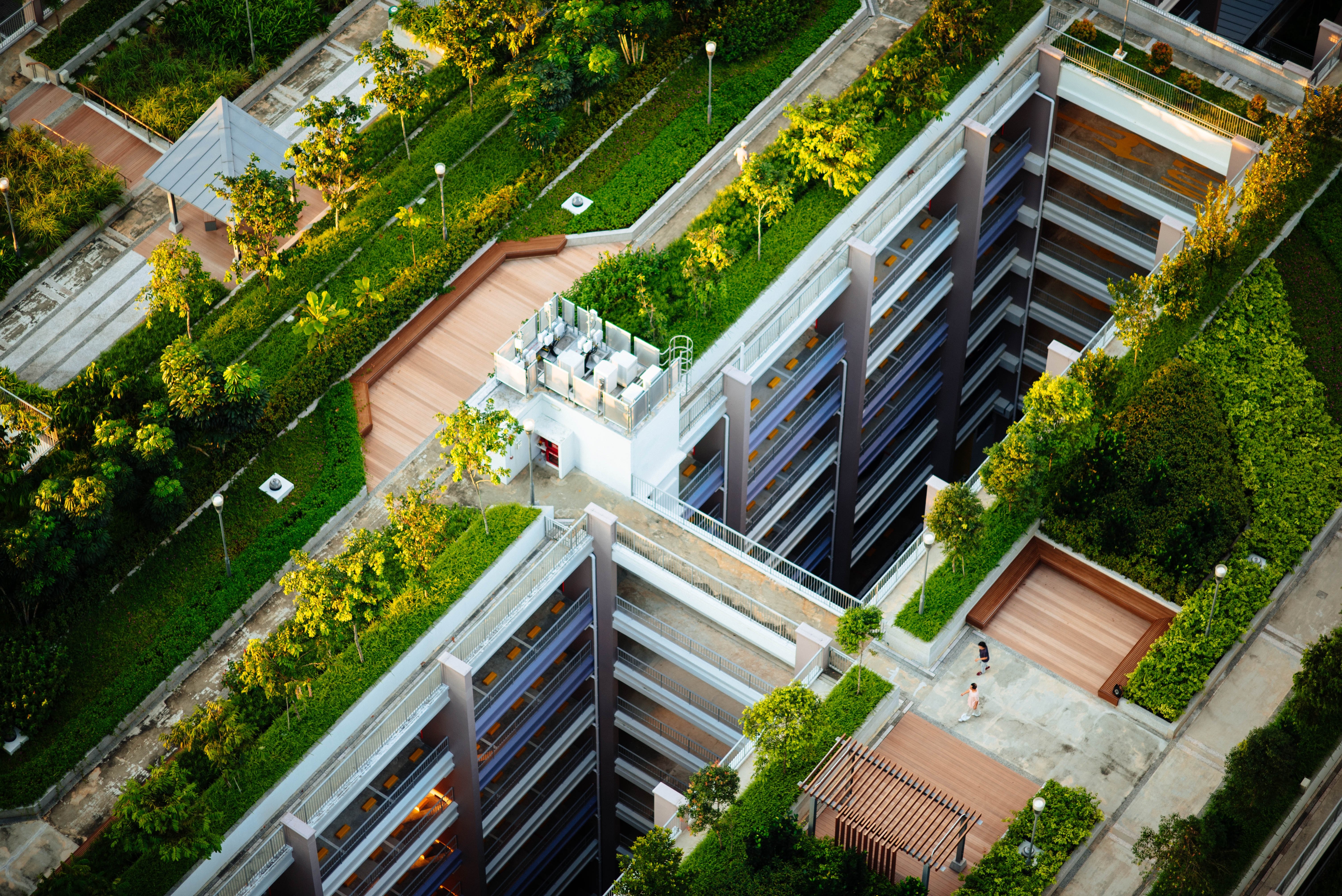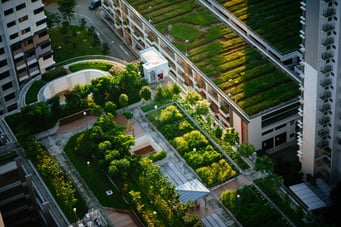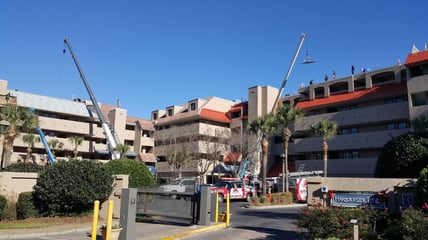
In an era marked by growing environmental concerns and a desire to harmonize with nature, the idea of living roofs emerged as an innovative and eco-friendly solution. These interesting concepts transform empty rooftops into vibrant, living ecosystems. But are they worth the hype?
RoofCrafters has been in the roofing game for almost thirty years, and we've replaced countless complex roofs. Finding the truth about living roof systems lies in the specifics of how they're installed and maintained, what they're made of, and the home or building they sit on. There's a lot to love about this particular roof type, but on the other hand, a few aspects make it difficult to carry out.
This article explores the nitty gritty behind green roofs, uncovering if they're a truly sustainable and long-lasting option or just a fad for eager plant growers and idealists. By the time you finish, you'll have a better idea if this is the roof option for you, whether you're looking to adorn your home or business. There's a lot to uncover, so get comfy. Are you ready to begin?
Living Roofs: The Pros
Living roofs, also known as green roofs or vegetated roofs, offer a range of advantages and disadvantages. Here are the notable pros of having one:
- Environmental Benefits: Living roofs contribute to urban biodiversity by providing habitats for plants, birds, insects, and other wildlife. They help mitigate the "heat island" effect, reduce air pollution, and absorb carbon dioxide, improving air quality and combating climate change.
- Stormwater Management: The vegetation and soil on living roofs act as natural filters, absorbing and slowing down rainwater runoff. This helps reduce the strain on stormwater systems, minimizing the risk of flooding and improving water quality by filtering pollutants.
.jpg?width=343&height=257&name=chuttersnap-VzFARELPZZQ-unsplash%20(1).jpg)
- Energy Efficiency: Living roofs provide excellent insulation, reducing heat transfer between the building and the external environment. They can help regulate indoor temperatures, leading to lower energy consumption for heating and cooling, resulting in reduced energy costs.
- Extended Roof Lifespan: The vegetation layer of a living roof protects the waterproofing membrane from harmful UV radiation, extreme temperatures, and physical damage caused by weather or debris. This protection can extend the roof's lifespan, reducing the need for premature replacements.
- Aesthetics and Well-being: Hey, you just have to be happy when you're on a roof surrounded by life. Such a simple and unusual notion is a super fun idea. Living roofs add visual appeal to buildings, enhancing the aesthetics of urban landscapes and promoting a connection to nature. The presence of greenery has been shown to improve mental well-being, reduce stress, and create a more pleasant and productive environment for home and business owners/employees.
As you can see, there are a lot of profound benefits to having plant life on your roof, like feeling happier overall and being more environmentally conscious. It's no wonder more business and homeowners alike are wondering about this option!
Living Roofs: The Cons
You can't have benefits without drawbacks- nothing is perfect. So what aspects contribute to living roofs having a complicated reputation? Let's uncover below:
- Cost: Installing a living roof can be initially more expensive than conventional roofing systems due to the additional components required, such as drainage layers, root barriers, and irrigation systems. However, you can experience long-term savings through energy efficiency and the extended roof lifespan.
- The Structure Itself: Living roofs are heavier than traditional roofing systems due to the added weight of soil, vegetation, and water. Proper structural reinforcement may be necessary to ensure the building can support the additional load. No one wants their home to cave in, but believe it or not, it happens.
- Maintenance: Living roofs require ongoing maintenance, including watering, fertilizing, pruning, and weed control. Regular inspections are necessary to address any issues promptly, such as plant die-off or drainage problems. Let's just say- if you aren't a passionate gardener or don't have a team of them to tend your living roof, this could be a bad choice for you.

- Limited Options: Not all buildings or structures suit living roofs. Factors such as roof slope, structural capacity, and sunlight exposure must be carefully considered before installation. Living roofs may not be practical or feasible for specific locations or building types, unfortunately.
- Installation Challenges: The installation of living roofs can be complex and requires specialized expertise. Proper waterproofing and installation techniques are crucial to prevent leaks and ensure the long-term success of the system as a whole.
Despite the challenges and considerations, the benefits of living roofs in terms of environmental sustainability, energy efficiency, and improved well-being make them an increasingly popular choice for eco-conscious building designs. All things considered, what would you choose? Are you a team living roof or a traditional team roof?
Diving Deeper into the Cost
Pricing is a huge factor that goes into roof replacement, and it's no secret that some roofs cost more than others. What goes into determining the cost of a living roof?
Roof Size and Complexity: The size of the roof is a primary factor in determining the cost. Larger roofs require more materials, labor, and time for installation. Additionally, roofs with complex designs, multiple levels, or irregular shapes may involve more intricate installation techniques, increasing the overall cost.
Structural Reinforcement: Before installing a living roof, a structural assessment of the building is necessary to ensure that it can support the additional weight of the vegetation, soil, and water. If reinforcement is required, such as adding other beams or supports, it will definitely add to the overall cost.
Waterproofing and Drainage Systems: Proper waterproofing is crucial to prevent water infiltration into the building. Specialized waterproofing membranes, root barriers, and drainage systems are necessary and essential components of a living roof. The quality and complexity of these systems can impact how much you'll pay.
Vegetation and Plant Selection: Most gardens ain't cheap! The types of plants and vegetation chosen for the living roof will influence the price. Certain plants may require specific soil mixtures, irrigation systems, or maintenance requirements, raising costs.

Irrigation Systems: Depending on the climate and plant selection, an irrigation system may be necessary to ensure the survival and health of the vegetation. The complexity and scale of the irrigation system will have an impact on your spending.
Maintenance Considerations: The long-term maintenance of a living roof should be factored into the cost. This includes regular inspections, weeding, fertilizing, pruning, and addressing any issues that arise over time. Fertilizer expenses are high right now, so take notes on prices and keep the future in mind.
Professional Installation: Installing a living roof requires specialized knowledge and expertise. Hiring professionals with experience in green roof installation ensures proper installation techniques and increases the likelihood of long-term success. The cost of professional installation will depend on the scope and complexity of the project. If you're interested in one, do some research on quality roofers in your area.

Local Regulations and Permits: Compliance with local building codes, permits, and regulations can add to the overall cost of a living roof. It's important to consider any additional expenses related to obtaining necessary approvals and adhering to specific requirements. Leave that part to your roofer, though.
It's vital to note that while the upfront cost of a living roof may be higher compared to conventional roofing systems, you can save money long-term through energy efficiency, extended roof lifespan, and environmental benefits. Consulting with a professional and obtaining detailed cost estimates based on your specific project is recommended to accurately assess the cost of having a living roof!
Are Living Roofs Right for Me?
Whether you ultimately decide on one or not, there's no denying that they're a compelling concept with numerous noted benefits. Though complicated and potentially unachievable for some, they offer several advantages like improved biodiversity, stormwater management, energy efficiency, possible extended roof lifespan, and enhanced well-being. By weighing their challenges (price, building codes, limited applicability, etc.) and rewards, you can get an idea of if this roof type is right for you.
That being said, reaching out to a qualified roofer for your living roof project is crucial. Because this is a concept on the rise, you may not find a lot of roofing professionals that feel comfortable building one for you. But- if you have any concerns or questions regarding your potential new roof, RoofCrafters is here for you! If you live in one of our service areas, help is just a phone call away. When you're ready, visit our contact page to connect with one of our friendly representatives.
My name is Kevin Mills, and I am the lead estimator for RoofCrafters’ Tampa division. I’m originally from Michigan, and I enjoy hunting, fishing, and spending any free time outdoors. What I’m most passionate about, though, is helping business owners and homeowners alike achieve their roofing goals, all while providing a seamless customer journey.





